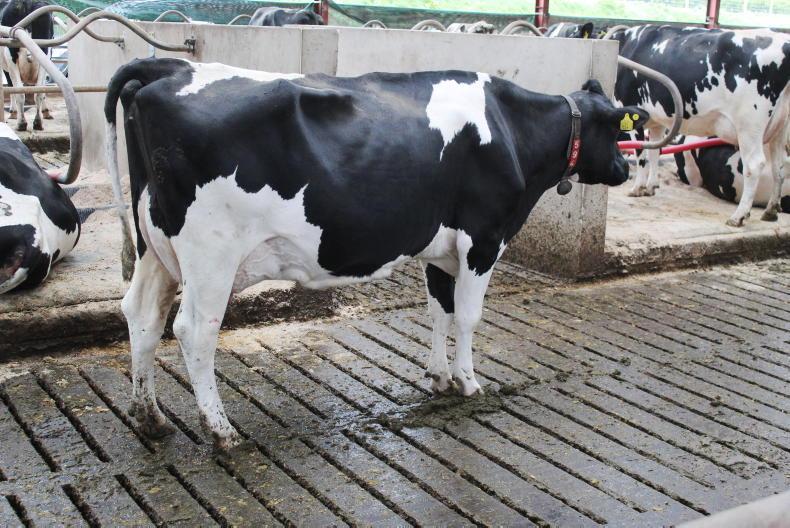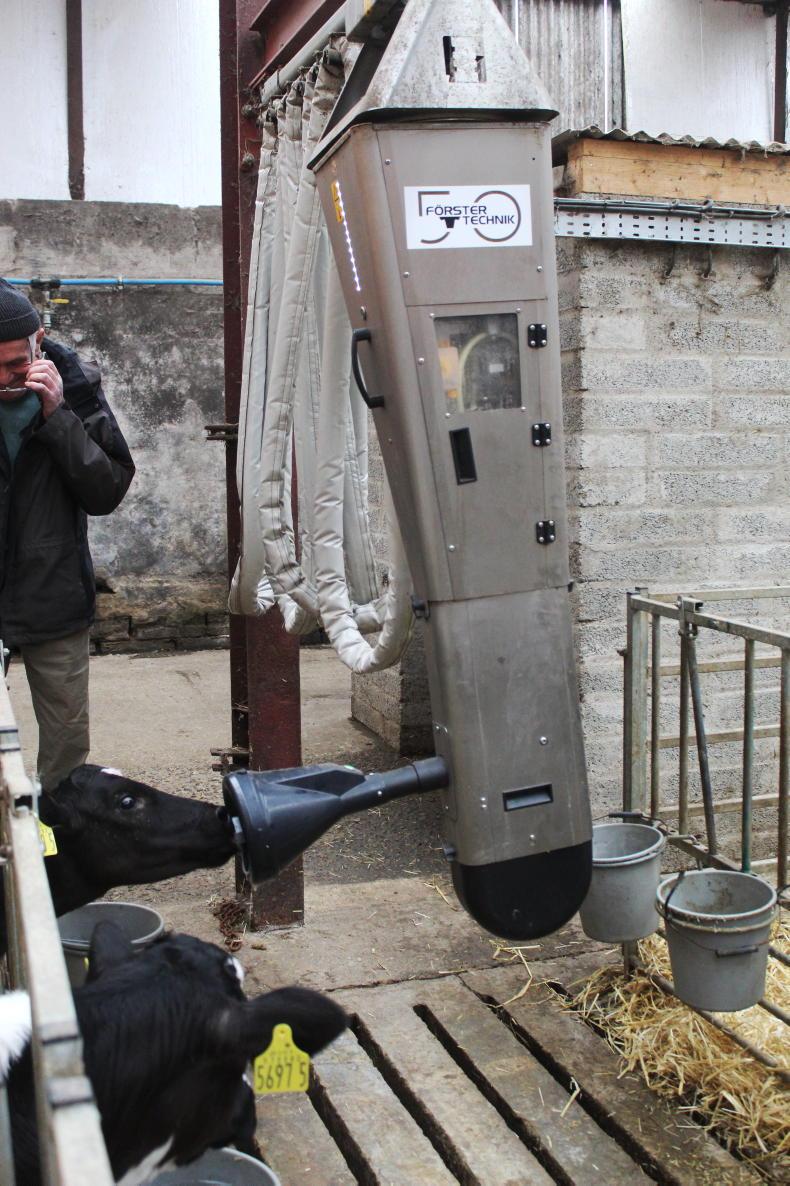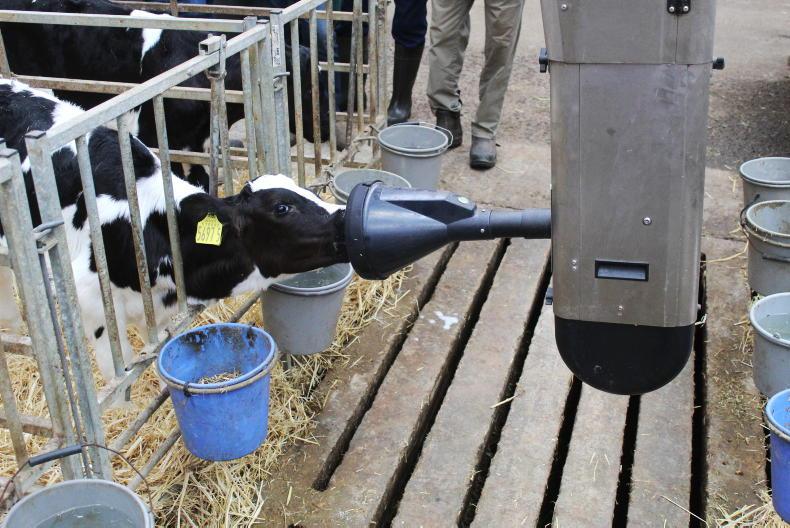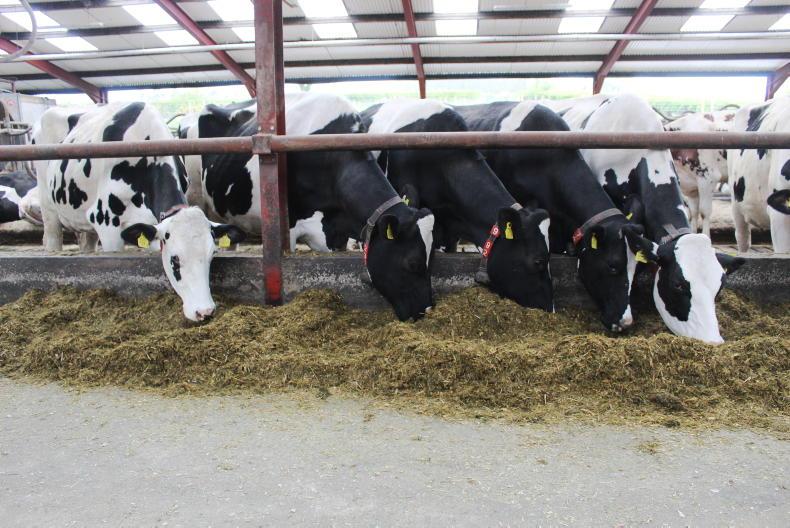Robotic milking and automation have become a cornerstone of modern infrastructure on dairy farms across Northern Ireland, one of which being Grove Dairy Holsteins.
Owned by the Mitchell family, Castlederg, investment in recent years has seen automation taking on key management tasks for the farm’s 750 pedigree dairy cows, plus young stock.
All cows are currently milked through robots with 14 units on farm, which are a combination of Lely A4 and A5 astronaut models.

Grove Dairy Holsteins, Castlederg.
While forage is offered via a diet feeder, once fed out, cow intakes are stimulated by regularly pushing up fodder using automated machines.
Slurry is scraped using mobile units, while the calf rearing house has moved to automated feeding.
Farm background
The current herd is managed by John Mitchell and established by his parents in 1968. From 1978, milk has been bottled on farm and sold under the Grove Dairy label.
When John finished college in the early 2000s, the herd was milking 270 cows on a three-times-per-day routine through a 16/32 herringbone parlour.
Feeling that the milking routine was too time-consuming for an expanding herd, John first looked into robots in 2005.
“At the time, there wasn’t many farms using robots and I was weary of some stories. So we opted for a 30/60 parlour to keep each milking to around one hour in duration,” outlined John to farmers attending the event.
As the Grove Dairy bottling business continued to grow, so did the dairy herd. By 2014, a second 60-point parlour was installed to keep milking time under one hour.

John first looked into robots in 2005.
“It was labour intensive with five staff in the two parlours during milking and one person chasing cows in.
“At its peak, we had the equivalent of 14 staff units and it was hard to manage. So we revisited the idea of robots with the herd growing to over 600 cows.”
In 2017, six robots were installed with a further three units in place three months later. Another two units went in two months later. Fourteen robots are now on farm, with staff dropping to seven people.
“The changeover was tough in terms of getting cows in milk trained on to robots. But, overall, it wasn’t as bad as I feared.

In 2017, six robots were installed with a further three units in place three months later.
“We used robots as out-of-parlour feeders, while still using the old parlour, to train cows, as well as a training box for dry cows and heifers. Once calved, they were quick to take to the robots.”
Herd details
Currently, there are 734 cows on robots averaging 38kg of milk daily at 4.12% butterfat and 3.24% protein, with animals averaging 184 days in milk. Cows are on track to average 40kg by June.
Milk yields have increased from just over 30 litres in the conventional parlour on a three times daily milking system.
Annual yield is 8.5m litres with the aim to hit 10.2m litres next year. Milk supplies the family owned pasteurization plant, with any surplus sold to Lakeland Dairies.

Cows are on track to average 40kg by June.
Cows calve all year round with the flat milk supply suiting the bottling plant, as well as managing robot throughput.
“The aim is to keep robots working to capacity every day of the year. I want each unit doing at least 2,000kg of milk every day, otherwise they are not being used efficiently.”
Feed programme
Cows are fed concentrate at a rate of 0.39kg per litre of milk produced.
Normally, cows are only fed forage through the diet feeder with 19kg of second-cut grass silage and 15kg of maize currently offered.
But this spring, 0.5kg/head of soya, 0.5kg of straw and 1.5kg of soya hulls are included to stretch forage supplies.
Second -cut silage is 27% dry matter (DM), 12.5% protein, 11.7 ME (energy) and 72 D-value. Maize silage is 36% DM, 28% starch and 11.5 ME.
Regular silage analysis means concentrate rations supplied through Clonleigh Co-op are tweaked to balance diets.
Cows in milk get a tailored-made 21% protein nut up to a maximum intake of 20kg/day, based on yields of 60 litres.
Dry cows are also fed a tailored nut at 4kg/day and once calved, they switch to 8kg of the 21% nut, then build up to 14kg by day 21 in milk.
From day 22 to 100 days, cows get a minimum 10kg concentrate and over 100 days, concentrate is fed to yield.
Intakes
Huge emphasis is placed on stimulating cow intakes by encouraging visits to the feed barrier, out-of-parlour feeder and robot.
Pushing in forage using automated machines has helped increase intakes, as has the introduction of a powdered mineral plant and oil extract supplied by Key Nutrition, which formulates all diets on farm.
Calf unit
As the herd is pedigree-registered, sexed Holstein semen is predominantly used with some beef semen on animals outside the desired breeding criteria.
Newborn calves are fed cow’s milk up to three weeks of age and John maintains this has delivered higher liveweight gains over powdered milk.

Cows in milk get a tailored-made 21% protein nut up to a maximum intake of 20kg/day, based on yields of 60 litres.
From four weeks of age up to weaning around 11 to 12 weeks, calves are fed powdered milk via a German-made Forster Technik machine.
Installed last year, the machine is the only one in Ireland. The unit has one teat on a robotic arm with a milk line attached to a mixing unit.
The teat moves between calf crates to allocate a preset volume of milk and sterlised between animals.
Calves are fed five times per day and housed in two climate-controlled sheds that each accommodate 60 animals in four rows of 15 individual pens.
Every week, calves are moved to the subsequent row of pens which are cleaned before use. After eight weeks on powdered milk, animals then move into larger loose pens and weaned.
Future plans
On the future plan for the herd, John is focusing on efficiency gains within breeding and nutrition, keeping milking speed in mind to maximise throughput of each robot.
“It’s about trying to weed out and improve yields from the bottom 5% of the herd. They are the animals that decide if we make a profit or not.”
Farm facts
750 Holstein cows.Producing 8.5m litres and rising to 10.2m.Cows milked on 14 Lely robots.Year-round calving profile.Milk sold through Grove Dairy and Lakeland. Read more
Dairy management: understanding the signs of heat
Watch: Gigginstown Angus bull hits €7,000
Robotic milking and automation have become a cornerstone of modern infrastructure on dairy farms across Northern Ireland, one of which being Grove Dairy Holsteins.
Owned by the Mitchell family, Castlederg, investment in recent years has seen automation taking on key management tasks for the farm’s 750 pedigree dairy cows, plus young stock.
All cows are currently milked through robots with 14 units on farm, which are a combination of Lely A4 and A5 astronaut models.

Grove Dairy Holsteins, Castlederg.
While forage is offered via a diet feeder, once fed out, cow intakes are stimulated by regularly pushing up fodder using automated machines.
Slurry is scraped using mobile units, while the calf rearing house has moved to automated feeding.
Farm background
The current herd is managed by John Mitchell and established by his parents in 1968. From 1978, milk has been bottled on farm and sold under the Grove Dairy label.
When John finished college in the early 2000s, the herd was milking 270 cows on a three-times-per-day routine through a 16/32 herringbone parlour.
Feeling that the milking routine was too time-consuming for an expanding herd, John first looked into robots in 2005.
“At the time, there wasn’t many farms using robots and I was weary of some stories. So we opted for a 30/60 parlour to keep each milking to around one hour in duration,” outlined John to farmers attending the event.
As the Grove Dairy bottling business continued to grow, so did the dairy herd. By 2014, a second 60-point parlour was installed to keep milking time under one hour.

John first looked into robots in 2005.
“It was labour intensive with five staff in the two parlours during milking and one person chasing cows in.
“At its peak, we had the equivalent of 14 staff units and it was hard to manage. So we revisited the idea of robots with the herd growing to over 600 cows.”
In 2017, six robots were installed with a further three units in place three months later. Another two units went in two months later. Fourteen robots are now on farm, with staff dropping to seven people.
“The changeover was tough in terms of getting cows in milk trained on to robots. But, overall, it wasn’t as bad as I feared.

In 2017, six robots were installed with a further three units in place three months later.
“We used robots as out-of-parlour feeders, while still using the old parlour, to train cows, as well as a training box for dry cows and heifers. Once calved, they were quick to take to the robots.”
Herd details
Currently, there are 734 cows on robots averaging 38kg of milk daily at 4.12% butterfat and 3.24% protein, with animals averaging 184 days in milk. Cows are on track to average 40kg by June.
Milk yields have increased from just over 30 litres in the conventional parlour on a three times daily milking system.
Annual yield is 8.5m litres with the aim to hit 10.2m litres next year. Milk supplies the family owned pasteurization plant, with any surplus sold to Lakeland Dairies.

Cows are on track to average 40kg by June.
Cows calve all year round with the flat milk supply suiting the bottling plant, as well as managing robot throughput.
“The aim is to keep robots working to capacity every day of the year. I want each unit doing at least 2,000kg of milk every day, otherwise they are not being used efficiently.”
Feed programme
Cows are fed concentrate at a rate of 0.39kg per litre of milk produced.
Normally, cows are only fed forage through the diet feeder with 19kg of second-cut grass silage and 15kg of maize currently offered.
But this spring, 0.5kg/head of soya, 0.5kg of straw and 1.5kg of soya hulls are included to stretch forage supplies.
Second -cut silage is 27% dry matter (DM), 12.5% protein, 11.7 ME (energy) and 72 D-value. Maize silage is 36% DM, 28% starch and 11.5 ME.
Regular silage analysis means concentrate rations supplied through Clonleigh Co-op are tweaked to balance diets.
Cows in milk get a tailored-made 21% protein nut up to a maximum intake of 20kg/day, based on yields of 60 litres.
Dry cows are also fed a tailored nut at 4kg/day and once calved, they switch to 8kg of the 21% nut, then build up to 14kg by day 21 in milk.
From day 22 to 100 days, cows get a minimum 10kg concentrate and over 100 days, concentrate is fed to yield.
Intakes
Huge emphasis is placed on stimulating cow intakes by encouraging visits to the feed barrier, out-of-parlour feeder and robot.
Pushing in forage using automated machines has helped increase intakes, as has the introduction of a powdered mineral plant and oil extract supplied by Key Nutrition, which formulates all diets on farm.
Calf unit
As the herd is pedigree-registered, sexed Holstein semen is predominantly used with some beef semen on animals outside the desired breeding criteria.
Newborn calves are fed cow’s milk up to three weeks of age and John maintains this has delivered higher liveweight gains over powdered milk.

Cows in milk get a tailored-made 21% protein nut up to a maximum intake of 20kg/day, based on yields of 60 litres.
From four weeks of age up to weaning around 11 to 12 weeks, calves are fed powdered milk via a German-made Forster Technik machine.
Installed last year, the machine is the only one in Ireland. The unit has one teat on a robotic arm with a milk line attached to a mixing unit.
The teat moves between calf crates to allocate a preset volume of milk and sterlised between animals.
Calves are fed five times per day and housed in two climate-controlled sheds that each accommodate 60 animals in four rows of 15 individual pens.
Every week, calves are moved to the subsequent row of pens which are cleaned before use. After eight weeks on powdered milk, animals then move into larger loose pens and weaned.
Future plans
On the future plan for the herd, John is focusing on efficiency gains within breeding and nutrition, keeping milking speed in mind to maximise throughput of each robot.
“It’s about trying to weed out and improve yields from the bottom 5% of the herd. They are the animals that decide if we make a profit or not.”
Farm facts
750 Holstein cows.Producing 8.5m litres and rising to 10.2m.Cows milked on 14 Lely robots.Year-round calving profile.Milk sold through Grove Dairy and Lakeland. Read more
Dairy management: understanding the signs of heat
Watch: Gigginstown Angus bull hits €7,000











 This is a subscriber-only article
This is a subscriber-only article











SHARING OPTIONS: